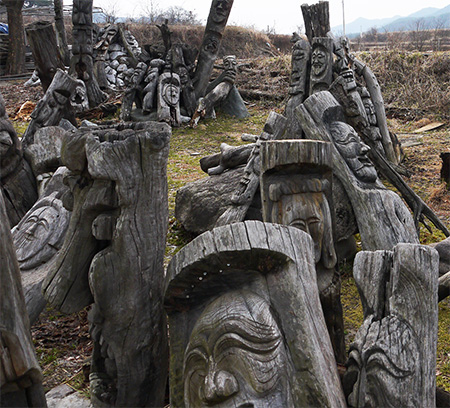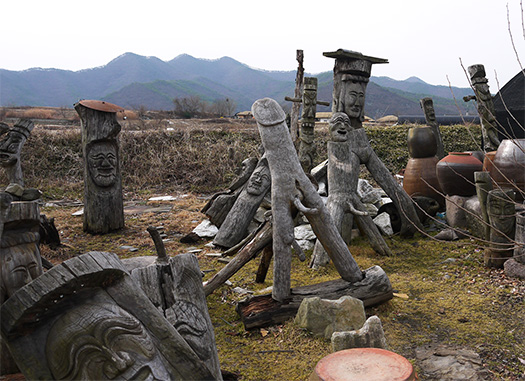

河回村と漢字で書いて韓国語では「ハフェマウル」と発音する。
とくに「マウル」というのは村というコトバの韓国語表現だろうけれど、
日本のムラという言語以上に思えるほど雰囲気が感じられる。
最初この語感を聞いて、その表現のまろやかさに驚いた。
マウルとムラと比較すればMとRの音であり同質性が強く感じられる。
黄色人種・東アジア的な同質性もあって、表面的には
対欧米ほどに距離感は感じない。それが自然な受け止め方だと思われる。
日本語表現では「かかいむら」っていうような言い方になるだろうけれど、
漢字文化圏とはいえ、語感ニュアンスではまったく適わない(笑)。
まぁ、北海道を中国語や韓国語で読むと似合わないと同義だろうか。
でもそこへいくと、東京とか大阪、札幌など呼び名が国際化している。
そういう普遍性志向も当然ありだけれど、ハフェマウルという土着独自性も
一方で非常に強いインパクトを与えてくれる。
国際化時代、その地方らしさがあってなお、普遍性を通じるというのは楽しい。
韓国での大きな目的地としてこの地名を耳にしたときから魅了されていた。
そういうエトランゼを出迎えてくれたのが写真の「道祖神」たち。
ユニークな表情の仮面彫刻群に交じって土俗的なシンボル彫刻もある。
よく東北の土俗として道祖神ワラ人形なども見ていたので、
そういった土俗の人類的共通性に強く打たれた。
日本のムラ社会とも通底するような空気感に一気に引き込まれる。
説明として他所からの疫病などの「魔除け」というように言われるけれど、
一種の「威嚇」というような地域としての主張もそこに感じる。
まるでゲゲゲの鬼太郎の魔界入口のようでもある。
怖ろしげだけれど、いかにもユーモアに通じる。
また、郷に入れば郷に従えという警句がこういう道祖神で語っているのか。
このようなトーテム文化は北方遊牧民やそこからベーリング海を渡った
アメリカインデイアンに特徴的といわれる風習ですが、
古層の人類的精神文化のなにごとかを伝えてきているものなのでしょう。
この仮面の表情はまた、布袋さんとか大黒さんの表情にも通じるし、
土俗性が強烈に味付けされた仮面舞踏劇の伎楽や雅楽の原型のようにも思える。
よそ者として警戒されつつ、どこかで諧謔性を伝えてくる。
この仮面たちはこの地の文化「河回別神グッ仮面舞」のモチーフと同様であり、
日本の仮面劇文化とも共通する人類性が表現されているのでしょう。
土俗的シンボルをかたどる彫像文化についてはシバ神あるいは
そのエネルギーの象徴として今日に至るまでインドの民衆に崇拝されている。
人類の大きな流れの海民の世界拡散において、南アジア〜東アジアを経て
北上を続けベーリング海を渡り、アメリカ大陸に向かった記憶が
こういう象徴文化を東アジア各地に痕跡として残したのだろうか。
安東市・河回村は洛東江水運を通じてこのような海民が根付いてきたか。
列島社会と大陸・半島社会の遠い記憶がつながる傍証なのだろう。
他国文化には言語で伝わる以上の始原的な体感の楽しさがある。
English version⬇
[Dosojin at the entrance of the village? Reminiscences of South Korea’s “Hahoemauru” -2]
Written in Kanji with Andong Hahoe Village and pronounced “Hafe Maul” in Korean.
In particular, “Maul” is probably the Korean expression for the village, Word.
You can feel the atmosphere more than the language of Japanese unevenness.
When I first heard this feeling, I was surprised at the mellowness of the expression.
Compared to Maul and Mura, the sounds are M and R, and the homogeneity is strongly felt.
On the surface, there is also the homogeneity of the yellow race and East Asia.
I don’t feel as far away as I do with Europe and the United States. That seems to be a natural way of thinking.
In Japanese, it would be something like “Kakaimura”, but
Even though it is a Kanji cultural sphere, it is not suitable for the nuances of words (laughs).
Well, isn’t it synonymous with reading Hokkaido in Chinese or Korean?
But when I go there, the names such as Tokyo, Osaka, and Sapporo are internationalized.
Of course, there is such a universality orientation, but there is also the indigenous uniqueness of Hafemaul.
On the other hand, it has a very strong impact.
In the age of internationalization, it is fun to pass through universality even though it has the locality.
I have been fascinated since I heard this place name as a big destination in Korea.
The “Dosojin” in the photo welcomed such Etranze.
There is also a folk symbol sculpture mixed with a group of masked sculptures with unique expressions.
I used to see Dosojin Wara dolls as a Tohoku tradition, so
I was strongly struck by the human commonality of such customs.
I am drawn to the atmosphere that is similar to the Japanese village-bonded society.
As an explanation, it is said to be “amulet” such as plague from other places, but
I also feel that there is a kind of “intimidation” claim as a region.
It’s like GeGeGe no Kitaro’s entrance to the demon world.
It’s scary, but it really leads to humor.
Also, is the epigram saying that if you enter the township, follow the township in this way of Dosojin?
Such totem culture crossed the Bering Sea from northern nomads and from there
It is a custom that is said to be characteristic of American Indians,
Perhaps it conveys something about the ancient human spiritual culture.
The facial expression of this mask is also similar to the facial expressions of Mr. Nunobukuro and Mr. Oguro.
It seems to be the prototype of Gigaku and Gagaku in masquerade, which is strongly seasoned with earthlyness.
While being wary of being a stranger, he conveys humor somewhere.
These masks are similar to the motif of the local culture “Kawakaibetsugami Good Mask Dance”.
Perhaps it expresses humanity that is common to Japanese masque culture.
For statue culture in the shape of a folk symbol, see Shiva God or
As a symbol of that energy, it has been worshiped by the Indian people to this day.
In the global diffusion of the sea people, which is a major flow of humankind, through South Asia to East Asia
I remember heading north, crossing the Bering Sea, and heading for the Americas.
Did these symbolic cultures remain as traces in various parts of East Asia?
Has such seafarers taken root in Andong City and Andong Hahoe Village through Nakdong River Water Transport?
It may be a proof that the distant memories of the archipelago society and the continental / peninsula society are connected.
Foreign cultures have more primordial enjoyment than can be conveyed in language.
Posted on 8月 20th, 2021 by 三木 奎吾
Filed under: 住宅マーケティング, 日本社会・文化研究, 歴史探訪







コメントを投稿
「※誹謗中傷や、悪意のある書き込み、営利目的などのコメントを防ぐために、投稿された全てのコメントは一時的に保留されますのでご了承ください。」
You must be logged in to post a comment.